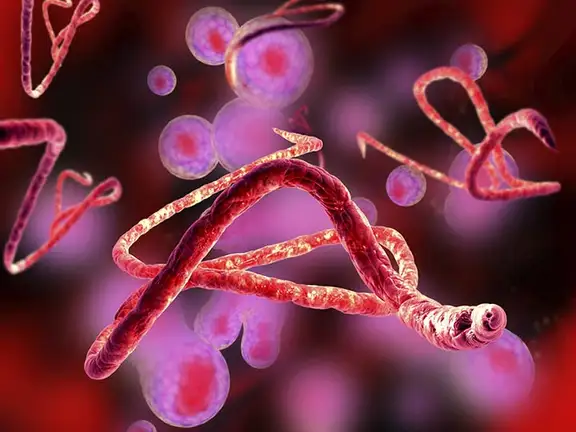Ebola virus disease (EVD), formerly known as Ebola hemorrhagic fever, is a severe, often fatal illness affecting humans and other primates. It first emerged in 1976 in simultaneous outbreaks in Nzara, South Sudan, and Yambuku, Democratic Republic of Congo (DRC), near the Ebola River, from which it takes its name.
History of Ebola Virus
The Ebola virus belongs to the Filoviridae family, genus Ebolavirus. The first recognized outbreak of EVD occurred in 1976, with subsequent sporadic outbreaks in Central and West Africa.
Causes and Transmission
Ebola virus is zoonotic, meaning it is transmitted to humans from animals. Fruit bats are believed to be the natural host of the virus. Human-to-human transmission occurs through direct contact with bodily fluids of infected individuals or contact with surfaces and materials contaminated with these fluids.
Symptoms of Ebola Virus Disease
The incubation period for EVD is typically 2 to 21 days after exposure to the virus, with symptoms including fever, severe headache, muscle pain, weakness, fatigue, diarrhea, vomiting, abdominal pain, and unexplained bleeding or bruising.
Diagnosis and Treatment
Diagnosing EVD can be challenging due to its nonspecific symptoms early in the course of the illness. There is currently no specific antiviral treatment for EVD, with supportive care being the mainstay of treatment.
Prevention and Control Measures
Preventing the spread of Ebola virus involves implementing infection control practices, such as hand hygiene, safe handling of bodily fluids, and appropriate use of personal protective equipment (PPE). Vaccines have been developed and used in outbreak settings to help control the spread of the virus.
Impact of Ebola Virus Disease
EVD outbreaks have significant social, economic, and health impacts on affected communities. The disease can disrupt healthcare systems, lead to loss of livelihoods, and result in stigmatization of survivors.
Recent Outbreaks
Recent outbreaks of EVD have occurred primarily in Central and West Africa, with the largest outbreak recorded in West Africa between 2014 and 2016. The outbreak resulted in over 11,000 deaths and highlighted the need for improved preparedness and response measures.
Global Efforts and Response
The international community has mobilized resources to support affected countries in responding to EVD outbreaks. Organizations such as the World Health Organization (WHO) and Médecins Sans Frontières (MSF) play key roles in providing medical care, surveillance, and coordination efforts during outbreaks.
Research and Development
Research into Ebola virus continues to advance our understanding of the disease and inform prevention and treatment strategies. Efforts are underway to develop new therapeutics and vaccines to improve preparedness for future outbreaks.
Public Awareness and Education
Raising awareness about Ebola virus transmission, prevention, and treatment is crucial for controlling outbreaks and reducing stigma associated with the disease. Community engagement and education campaigns help disseminate accurate information and promote behavior change.
Ebola Virus Disease and Wildlife
The role of wildlife, particularly bats, in the transmission of Ebola virus underscores the importance of addressing the human-animal interface to prevent future outbreaks. Conservation efforts and research into bat ecology are essential for understanding and mitigating the risk of spillover events.
Challenges in Managing Ebola Virus Disease
Challenges in managing EVD include limited healthcare infrastructure, mistrust of authorities, and cultural practices that facilitate transmission. Addressing these challenges requires a multisectoral approach involving healthcare, public health, and community engagement.
Future Outlook
Despite progress in understanding and managing Ebola virus, the risk of future outbreaks remains. Continued investment in research, surveillance, and preparedness is essential for mitigating the impact of EVD and preventing its spread.
Conclusion
Ebola virus disease remains a significant public health threat, with periodic outbreaks occurring in Africa and the potential for global spread. Effective prevention, detection, and response measures are essential for controlling the spread of the virus and minimizing its impact on affected communities.

